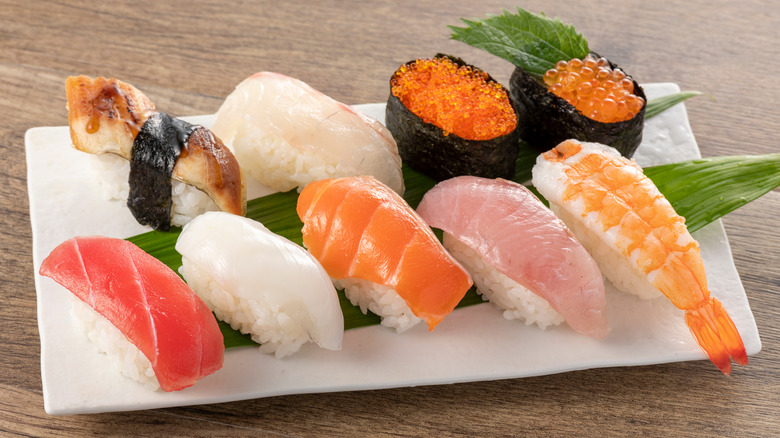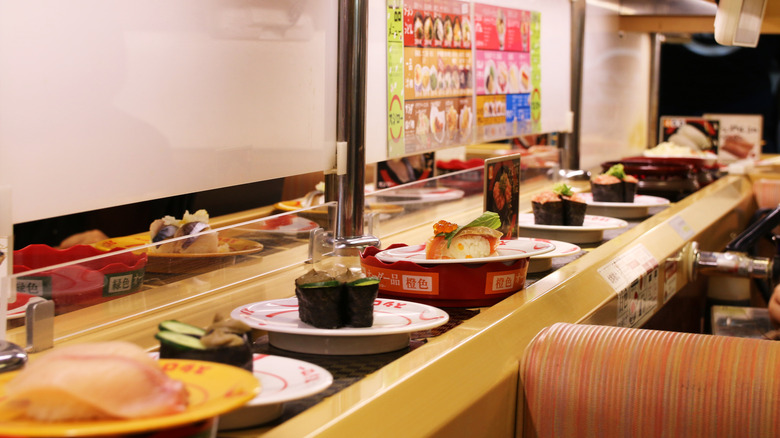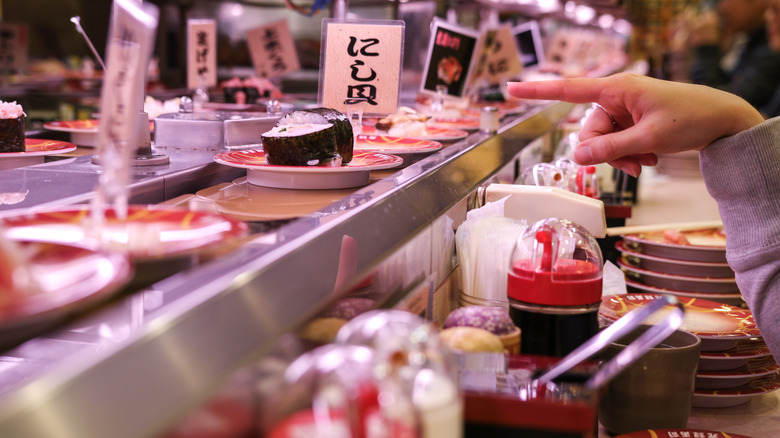How 'Sushi Terrorists' Are Ruining Conveyor Belt Sushi
While people have been enjoying sushi as far back as the fifth century BC, conveyor belt sushi is a relatively new phenomenon. Innovator Yoshiaki Shiraishi came up with the concept after being inspired by the way beer bottles moved through a brewery. After much brainstorming, he opened Mawaru Genroku Sushi in 1958, which quickly became a hit with diners throughout Osaka, Japan.
While sushi purists questioned the quality of mass production, customers loved the novelty of the conveyor belt system. Shiraishi's innovation also helped a new class of customers enjoy sushi thanks to the more reasonable prices offered by conveyor belt establishments. As a result, the restaurant concept took flight and spread to numerous countries all over the world. Shiraishi is now considered an icon of Japanese culinary culture, both for his invention and his ability to face down criticism as he attempted to bring his idea to life. That's why it's so unfortunate that his innovative idea is currently being tarnished by a few bad individuals.
Pranksters are taking a toll on conveyor belt restaurants
CNN reports on the troubling trend of sushi "pranksters" and their impact on multiple restaurants. The most recent transgression occurred at Sushiro, a beloved establishment in Japan. In the video, which was uploaded to TikTok, a customer is seen taking items from the belt and licking them, then placing them back into rotation. The customer also licks his finger and places it on a piece of sushi rolling by. Even more disturbing, these thoughtless behaviors appear to be part of a trend, as many other diners at different establishments are shown pulling similar stunts.
According to CNN, Sushiro filed a police report against the man responsible for the prank, with other establishments taking similar legal actions. However, the damage may already be done, as shares in the company that owns Sushiro decreased by 4.8% after the incident. Diners in Japan are also wondering if there's still a place for conveyor belt sushi in a post-COVID world. In response, Sushiro changed its serving practices by presenting customers with photos of food on the conveyor belt, which can be ordered directly from the server. While new serving practices will spare diners from receiving contaminated utensils or food, it's a shame that all customers can't stick to the agreed-upon etiquette.
A diner's guide to conveyor belt sushi
Even well-intentioned sushi lovers may find themselves committing a faux pas on their first trip to a conveyor belt sushi establishment. That's why proper etiquette is a must when enjoying kaitenzushi (aka conveyor belt sushi). When it comes to pricing, many establishments use color-coded plates to indicate the cost of a dish, while others set a flat rate for all menu items. Many invite customers to sit at the counter, but table service is also common in a number of restaurants. In either case, you'll be situated close to the conveyor belt to ensure you can remove dishes with ease.
You're free to take plates off the conveyor belt as they go by, or you can place a specific order that will be brought to you directly. Specific orders will either be provided by the waitstaff, or they'll be ferried to you via a sushi train. Once you're finished eating, the server will tally up your bill based on the number and color of plates, if applicable. As for kaitenzushi blunders, diners are asked never to place their empty plates back on the belt or touch any plates they don't intend on eating. If only the recent spate of sushi terrorists were privy to this bit of common-sense information.


